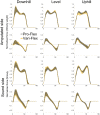Increasing prosthetic foot energy return affects whole-body mechanics during walking on level ground and slopes
- PMID: 29599517
- PMCID: PMC5876366
- DOI: 10.1038/s41598-018-23705-8
Increasing prosthetic foot energy return affects whole-body mechanics during walking on level ground and slopes
Abstract
Prosthetic feet are designed to store energy during early stance and then release a portion of that energy during late stance. The usefulness of providing more energy return depends on whether or not that energy transfers up the lower limb to aid in whole body propulsion. This research examined how increasing prosthetic foot energy return affected walking mechanics across various slopes. Five people with a uni-lateral transtibial amputation walked on an instrumented treadmill at 1.1 m/s for three conditions (level ground, +7.5°, -7.5°) while wearing a prosthetic foot with a novel linkage system and a traditional energy storage and return foot. The novel foot demonstrated greater range of motion (p = 0.0012), and returned more energy (p = 0.023) compared to the traditional foot. The increased energy correlated with an increase in center of mass (CoM) energy change during propulsion from the prosthetic limb (p = 0.012), and the increased prosthetic limb propulsion correlated to a decrease in CoM energy change (i.e., collision) on the sound limb (p < 0.001). These data indicate that this novel foot was able to return more energy than a traditional prosthetic foot and that this additional energy was used to increase whole body propulsion.
Conflict of interest statement
Author W.L.C. received financial compensation from Össur EHF, Reykjavik, Iceland to analyze the data and prepare this publication for submission. Össur EHF did not provide input on data analysis or data interpretation. Publication of this work was not contingent on prior approval by Össur EHF.
Figures





Similar articles
-
The effects of a controlled energy storage and return prototype prosthetic foot on transtibial amputee ambulation.Hum Mov Sci. 2012 Aug;31(4):918-31. doi: 10.1016/j.humov.2011.08.005. Epub 2011 Nov 17. Hum Mov Sci. 2012. PMID: 22100728 Free PMC article.
-
Systematic variation of prosthetic foot spring affects center-of-mass mechanics and metabolic cost during walking.IEEE Trans Neural Syst Rehabil Eng. 2011 Aug;19(4):411-9. doi: 10.1109/TNSRE.2011.2159018. Epub 2011 Jun 23. IEEE Trans Neural Syst Rehabil Eng. 2011. PMID: 21708509 Free PMC article.
-
The effects of prosthetic foot stiffness on transtibial amputee walking mechanics and balance control during turning.Clin Biomech (Bristol). 2017 Nov;49:56-63. doi: 10.1016/j.clinbiomech.2017.08.003. Epub 2017 Aug 15. Clin Biomech (Bristol). 2017. PMID: 28869812
-
Experimental characterization of the moment-angle curve during level and slope locomotion of transtibial amputee: Which parameters can be extracted to quantify the adaptations of microprocessor prosthetic ankle?Proc Inst Mech Eng H. 2021 Jul;235(7):762-769. doi: 10.1177/09544119211006523. Epub 2021 Mar 30. Proc Inst Mech Eng H. 2021. PMID: 33784889
-
Energy storage and return prostheses: does patient perception correlate with biomechanical analysis?Clin Biomech (Bristol). 2002 Jun;17(5):325-44. doi: 10.1016/s0268-0033(02)00020-7. Clin Biomech (Bristol). 2002. PMID: 12084537 Review.
Cited by
-
Subject-specific responses to an adaptive ankle prosthesis during incline walking.J Biomech. 2019 Oct 11;95:109273. doi: 10.1016/j.jbiomech.2019.07.017. Epub 2019 Jul 26. J Biomech. 2019. PMID: 31431348 Free PMC article.
-
Automated characterization of anthropomorphicity of prosthetic feet fitted to bone-anchored transtibial prosthesis.IEEE Trans Biomed Eng. 2019 Mar 13:10.1109/TBME.2019.2904713. doi: 10.1109/TBME.2019.2904713. Online ahead of print. IEEE Trans Biomed Eng. 2019. PMID: 30872221 Free PMC article.
-
Prosthetic push-off power in trans-tibial amputee level ground walking: A systematic review.PLoS One. 2019 Nov 19;14(11):e0225032. doi: 10.1371/journal.pone.0225032. eCollection 2019. PLoS One. 2019. PMID: 31743353 Free PMC article.
-
How does ankle power on the prosthetic side influence loading parameters on the sound side during level walking of persons with transfemoral amputation?Prosthet Orthot Int. 2022 Aug 1;46(4):306-313. doi: 10.1097/PXR.0000000000000099. Epub 2022 Mar 22. Prosthet Orthot Int. 2022. PMID: 35315835 Free PMC article.
-
Therapeutic benefits of lower limb prostheses: a systematic review.J Neuroeng Rehabil. 2023 Jan 13;20(1):4. doi: 10.1186/s12984-023-01128-5. J Neuroeng Rehabil. 2023. PMID: 36639655 Free PMC article.
References
-
- Geil MD. Energy loss and stiffness properties of dynamic elastic response prosthetic feet. Journal of Prosthetics and Orthotics. 2001;13:70–73. doi: 10.1097/00008526-200109000-00011. - DOI
Publication types
MeSH terms
Grants and funding
LinkOut - more resources
Full Text Sources
Other Literature Sources
Medical

